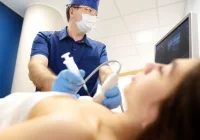Diffusion-weighted imaging (DWI) probes tissue microstructure by capturing water motion and translating it into contrast that supports detection, characterisation and treatment assessment across brain and body. Diagnostic value depends on coherent protocol choices, control of artefacts and disciplined interpretation with the apparent diffusion coefficient (ADC). Harmonised acquisition and processing reduce variability between scanners and sites, while strategies for motion, distortion and fat suppression preserve spatial fidelity and lesion conspicuity. The following recommendations by the European Society for Magnetic Resonance in Medicine and Biology outline efficient parameters for clinical workflows, highlight pitfalls such as T2-shine-through and signal pile-ups, and summarise priority applications in neurology and oncology.
Acquisition and Protocol Optimisation
Single-shot echo-planar imaging is preferred for clinical DWI due to speed and robustness. Long repetition times with the shortest feasible echo time help limit unwanted T1 and T2 influences and sustain signal-to-noise ratio. Monopolar diffusion encoding suits systems with effective eddy current compensation, while bipolar encoding can help where eddy effects are stronger. Simultaneous multi-slice can accelerate imaging but may introduce residual T1-weighting and reduce signal, so throughput gains should be balanced against contrast fidelity.
Must Read: Deep Learning MRI Halves Time While Preserving Quality
B-value selection should reflect anatomy and clinical intent. Brain protocols typically use low to moderate diffusion weightings to capture core contrast, while body protocols adopt slightly lower baselines and add higher b-values when signal permits to improve lesion conspicuity. As diffusion weighting increases, signal falls, averaging can be adjusted to balance noise. Parallel imaging or segmented readouts can reduce echo time and geometric distortion at a cost in signal or time. Outside the brain, respiratory or cardiac synchronisation improves robustness for organs such as liver or heart, though scan time and repetition interval variability may rise. Reliable fat suppression remains essential to avoid obscured lesions and ghosting.
Direction schemes should match anisotropy. For routine tasks, a b=0 image plus a small set of diffusion-weighted directions enables practical ADC estimation with limited directional bias. In anisotropic tissues such as white matter or kidney, at least six non-collinear directions within a diffusion tensor imaging framework provide more reliable values. Reporting diffusion time, where available, improves reproducibility across vendors. Console-side generation of ADC maps and trace-weighted images streamlines workflows, and retaining unprocessed data enables retrospective analysis and future-proofed post-processing.
Interpretation and Artefact Control
Confident reading relies on paired evaluation of DWI and ADC. Restricted diffusion appears bright on DWI and low on ADC, whereas facilitated diffusion shows the inverse. T2-shine-through can mimic restriction when long T2 components drive DWI hyperintensity, an elevated ADC distinguishes this from true restriction. Susceptibility-induced distortion and signal pile-ups near air or metal can displace or exaggerate findings and complicate alignment with structural images. Prospective B0 shimming, parallel imaging, segmented readouts or non-EPI options can reduce these effects, while field-map or image-based corrections further improve spatial accuracy.
Motion and eddy currents misalign diffusion volumes and blur detail, affecting both image quality and quantitative outputs. Vendor and open-source correction tools help restore geometry and lesion conspicuity. Parameter-derived images offer efficiency but require caution. ADC maps from a small number of directions or trace images are pragmatic in busy settings, though residual cross-term effects in anisotropic tissues argue for diffusion tensor approaches when precision is critical. Calculated high b-value images can heighten contrast for detection, but they extrapolate from acquired data and may not reflect non-Gaussian behaviour at very high weightings, so they complement rather than replace acquired measurements.
Clinical Applications in Neuro and Oncology
In acute neuroimaging, DWI detects ischaemia early by revealing reduced diffusion before conventional changes, with ADC evolving over time. Differentiation between abscess and necrotic tumour benefits from DWI-ADC pairing. For skull base evaluation, non-EPI diffusion reduces distortion and supports surveillance tasks such as cholesteatoma assessment.
Across oncology, DWI supports detection, characterisation and response monitoring. In the breast, diffusion metrics assist in distinguishing benign from malignant lesions and contribute to nodal assessment. In the prostate, DWI is central within multiparametric MRI and structured reporting, enhancing detection and risk stratification, particularly in the peripheral zone. In the liver, restricted diffusion serves as an ancillary feature to identify viable tumour and to support post-treatment evaluation. Whole-body DWI extends diffusion’s role to screening in defined high-risk contexts, staging and therapy monitoring, with background body signal suppression improving visualisation while requiring caution for precise quantitative use.
Consistent diffusion MRI relies on coherent acquisition, effective artefact control and joint DWI-ADC interpretation. Aligning b-values, timing, direction schemes and suppression methods with anatomy and clinical questions stabilises quality, while correction strategies for distortion, motion and eddy currents improve spatial fidelity and quantification. Within neurology and oncology, DWI complements structural imaging for early detection, characterisation and response monitoring, with whole-body protocols broadening reach. Standardised implementation strengthens diagnostic confidence, enables comparable reporting across sites and supports patient care through more reproducible diffusion MRI.
Source: European Radiology
Image Credit: Freepik










